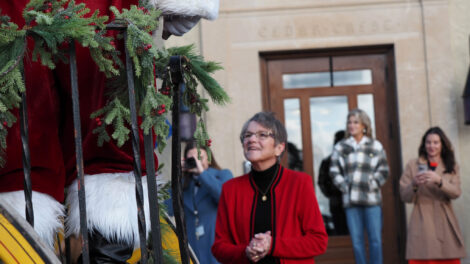In the end, just a home
A house with a history of murder finds new life
Space is one of the things Donna Mader likes best about her house.
So much in fact, that when she moved there in 1990, she hardly knew how to fill it all. Having been cramped with six children into a smaller place on the main highway for years, Donna simply didn’t have enough stuff.
Possessions have a tendency to accumulate, though, and over time, Donna and her husband Leonard, a retired farmer with a broad face, have managed to settle in. His vitamin bottles have gathered in the corners. Her snow village collection has colonized parts of the living room,
office and upstairs hallway. Pictures of their 15 grandchildren, some of whom often sleep over, hang everywhere.
Along with the extra closets and bedrooms in this house came something else, a lingering history. The Maders own the house on Holcomb’s southwestern edge, at the end of a long drive lined with dying Chinese elm trees, but the place will always be synonymous with another name: Clutter. The story of a family killed there 45 years ago draws strangers to the doorstep, driveway and telephone, constantly reminding the Maders that their home will never be only theirs.
The couple looks at the Clutter legacy with ambivalence. Although they resent their ever-violated privacy, they speak glowingly of the interesting people they’ve met because of it. In one instant, they talk of turning the house into a bed and breakfast; in another, they look forward to the prospect of selling it on eBay.
Respectful of the structure’s original inhabitants, the Maders have maintained many of the house’s original features and decor. Bench seats in the breakfast nook in the kitchen retain their original blue vinyl covering. Wood paneling on the dining room walls and the carpet the last owners laid over the oak floors have been removed. But the frame-and-brick house is hardly a shrine to an old tragedy. It’s a warm setting for lives that go on, a place for a sprightly, graying farmer’s wife to hold evening card parties and holiday noodle-making sessions with her grandchildren.
A house on the plains
In his 1965 book, “In Cold Blood,” Truman Capote described the house Donna and Leonard Mader now live in as “a place people pointed out.”

Donna Mader cuts and presses homemade dough for noodles with her young assistant, Bryce Druessel, the son of her son's fiance. They're sitting on blue naugahyde upholstery installed by the Clutter family.
“Situated at the end of a long, lanelike driveway shaded by rows of Chinese elms, the handsome white house, standing on an ample lawn of groomed Bermuda grass, impressed Holcomb,” Capote wrote.
Still an impressive structure by the town’s standards, the two-story farmhouse was an architectural anomaly on the plains of southwestern Kansas when it was built in 1948 for $40,000.
Forty-five years later, the property shows signs of major change. Some are harsh: No Trespassing marked along the lane, proud elms withered by a prolonged drought. Behind farm equipment sheds, another original structure sags. The Stoecklein house, named after the resident hired hand who didn’t hear the gunshots the night the Clutters were killed, decays into the ground, a favorite target of local graffiti artists. Other evidence of time’s passage is more benign: the white house re-sided in mauve, a trailer moved next to it and painted to match.
Sitting on a huge expanse of grass, the Maders’ spacious home appears dwarfed from the outside. But Herb Clutter’s highly personalized design features 14 rooms, including two bathrooms, an excess unheard of at a time when not everyone in the area had running water, Donna says.
In the office, she begins a tour she’s given hundreds of times, noting the absence of a safe then and now. The idea of a safe is what brought two killers into the house in 1959.
Hardly seeming the serious place of business Capote described, the room still contains a desk and chair. Dozens of glossy school photos of her grandchildren and great-grandchildren hang framed on the walls.
Passing back through the living room, by one of the home’s two wood-burning fireplaces, Donna heads for the master bathroom and Herb Clutter’s, now her, bedroom.
Especially elegant, the bathroom is original, Donna boasts. Pink tiles line the walls; white and brown ones alternate along the floor. A translucent blue tile divider separates the tub and toilet.
Donna goes next to the basement, where two murders occurred, casually drawing attention to a rusty stain on the wall, near where Herb Clutter’s body was found.
“This is supposed to be blood,” Donna says.
Once a meeting place for 4-H clubs and a space for a boy’s carpentry projects, the main area of the basement is still a playroom, now for tots and teens. The floor has been littered with toys and sleeping bags, Mader grandchildren romping in the same spot Kenyon Clutter was killed, sitting at the Clutters’ picnic table, which Kenyon might well have helped build.
Hurrying the procession along, Donna climbs back into the kitchen and the heart of the house, where she pauses long to marvel.
Her reverence for Clutter’s personal design shines through most here, where she believes he had his wife and three daughters in mind. Grateful of his foresight herself, Donna stores her forks and knives in pre-partitioned silverware drawers and sweeps dust into a floor chute ingeniously located behind a small, metal door on one end of a cabinet.
Genuine delight crosses her face when she asks her guests to guess the purpose of a piece of wood she pulls from between two drawers. Having stumped another set of visitors, she explains that, too low to be a cutting board, it’s a step for little girls who are too short to reach the highest cabinet.
Donna finishes the tour in the lavender-scented upstairs, where two more murders once took place.

The lane leading to the old Clutter home at River Valley Farm is still lined with Chinese elms. The current owners, Donna and Leonard Mader, have lived there longer than the Clutters did.
Three of the four upstairs bedrooms Herb Clutter designed for his family still remain as bedrooms. All but the biggest, which was Kenyon Clutter’s, bear a distinctly feminine touch. The smallest, formerly Nancy Clutter’s, has been converted into a computer room.
“We used to have a bed in there, but the kids won’t sleep in there,” Donna says.
A practical woman, she is more interested in cabinet space than who used to sleep where. She can’t help but wonder why, when the killers shut them in the bathroom, the Clutters didn’t block the door with the cupboard drawers.
With the drawers pulled out, Donna says as she demonstrates, the killers couldn’t have re-entered the bathroom, and the Clutters might have escaped through a window.
The life of a house
Like many Holcomb residents, the Maders say they’ve never read Truman Capote’s book.
They can remember for themselves when their house became infamous. Nov. 15, 1959, the day a whole family was discovered shot to death inside it.
“That was the most gruesome day. Pheasant season had just opened. We had just had a light snow,” Donna trails off.
From her house on the highway, Donna saw a hearse drive back and forth from the Clutter place four times. “I can remember seeing it come out and go back,” she says.
Unlike her husband, who saw Herb Clutter every day, Donna didn’t know the family well before their deaths. But she would feel the impact of their loss, along with the rest of the town.
Paranoia gripped Holcomb as word of the murders spread. No one could sleep, Donna recalls. People who were afraid to stay in their own homes stayed at the Maders’ old house for days. Leonard sealed the windows with 16-penny nails.
“It was one of the scariest times in my life,” Donna says.
During the next 30 years, as Holcomb tried to forget the tragedy, the Maders got to know the new occupants of the Clutter house. Leonard farmed the fields and kept watch over the house when Bob Byrd, a divorced cattle rancher and the farm’s new owner, was out of town. Donna played cards in the parlor with his relatives.
Always rotating between ranches, Byrd, who bought the house in 1964, was hardly ever around Holcomb. That made it easy on the film crew when scenes for the 1967 movie, “In Cold Blood,” were shot in the house.
When he committed suicide, Byrd helped add another morbid twist to the legacy of the house. To Donna’s relief, he ended his life elsewhere.
Leonard and Donna bought the house in 1990 from Byrd’s relatives, two of whom lived there after his death. The Maders got to know Byrd’s son and daughter-in-law well in the 1980s over cards and coffee.

The old Clutter family farmhouse today is a substantial home enlivened by a family with children and grandchildren. The house, which is owned by Donna and Leonard Mader, still draws visitors from around the world.
The process of considering whether to buy the house is a topic Leonard and Donna don’t spend a lot of time talking about. Leonard says simply, “The price was right.”
It was very right, according to a deed obtained from the Finney County Assessor. The official document states that the Maders paid “$1 and other valuable consideration” to the eight people then sharing ownership of the land.
In spite of all the evenings she’d spent in the dining room, Donna says she had never been all the way through the house until she and Leonard bought it.
Realizing instantly the potential the place had for family get-togethers, where her large clan could comfortably sprawl, Donna says she considered the big house a step up. She looked forward to moving off the highway, onto a more quiet spread outside of town.
Point of interest
Quiet, however, does not describe the Maders’ experience in their home the past 14 years.
Someone is always showing up at the end of the lane with a camera and the same old questions about what it’s like to live in a house where four people were murdered.
Having been acquainted with the former owners of the house, it’s not the attention that surprises the Maders. It’s how long the attention has lasted.
“I would think that it would have let up by now,” Donna remarks.
| “In Cold Blood: A Legacy,” the story of people hoping for decades that the world will forget, airs at 11:30 p.m. Wednesday on Sunflower Broadband Channel 6. |
But 45 years after the killings that inspired a book by Capote and two movies, the curious and the crazy still come calling, in the middle of the day or night, whether Donna has dusted recently or not.
“Sometimes it can get pretty aggravating,” she admits.
Her sons Bryan and Wes, who live in a trailer on the property, have resorted to firing shots in the air to scare off trespassers. Donna doesn’t like the tactic but thinks it’s effective.
Most of the time, she says, disturbances are limited to teenagers parking or sneaking around the broken-down Stoecklein house. Occasionally, though, frightening people have turned up at the door, such as a psychic their granddaughter mistook for a witch.
Reluctantly, they agreed to a quick tour for the woman from New Mexico, who said she’d been dreaming about the house. Donna says she had to cut short the chitchat after the woman began offering a theory that the Clutters weren’t really dead.
“My thinking didn’t run on the same lines,” Donna says.
However eccentric, most of the people their house has drawn into their lives haven’t been dangerous. In sharing the stories heard from visitors from 30 countries, the Maders seem almost proud. “We’ve met a lot of nice people,” Donna says.
That list includes a police investigator from Los Angeles (“a person from Dragnet” as Leonard says), an old, rich Dutch woman, cross-country bicyclists and actor Sam Neill, the New Zealand actor who stopped by to pick up a local accent for his role as Kansas Bureau of Investigation Agent Alvin Dewey Jr. in the 1996 television version of “In Cold Blood.”
“He wanted to talk like Leonard talks,” Donna says.
Even the psychic woman, who eventually returned, wasn’t the wicked witch she initially seemed. She sent members of the family birthday cards for years. The realization that none have come lately seems to worry Donna. “Something must have happened to her,” she says.
It’s in part because the structure’s history was beginning to overshadow their own lives that the Maders began giving paid tours in the early 1990s. The short-lived idea to charge $5 per head for a walk-through came about as a way to compensate themselves for their involuntary posts as historians.
They stopped the tours after just a few months due to resistance from those connected with the Clutter case and the personal stress of having to keep a constantly tidy house, Donna says.
During that time, she says, she fielded accusations, mostly anonymous, of trying to profit off the Clutters’ misfortune. A look of mischief crosses her face when she mentions the mail condemning her to hell.
“I had lots of letters telling me how horrible I was,” Donna chuckles.
While she is able to brush aside religious fanaticism, Donna has a harder time accepting the reservations of the surviving Clutters. Her soft face grows stern when she talks about Herb Clutter’s living daughters, who she’s convinced made money from — or at least gave their blessing to — the book and films that have kept interest in the story alive.
“I have to put up with all the people,” she says. “I didn’t write the book or make the movie, but I have to deal with all the people.”
In the end, just a home
Big enough for two family histories, the house has been the Maders’ now for more time than it was the Clutters’.
Donna stands in the dim light of the upstairs hallway, outside the door to a room where the youngest Clutter spent his last night of life almost 45 years ago to the day.
Still masculine in decor, the room is no one’s in particular now; a guest room.
As many others in this rural community would point out, life must go on. Even on its anniversary weekend, Donna Mader can’t afford to waste energy agonizing about a 45-year-old mass killing. Not when she’s got a card game to prepare for and three beaming grandchildren coming through her kitchen, one begging Grandma for a kiss.








